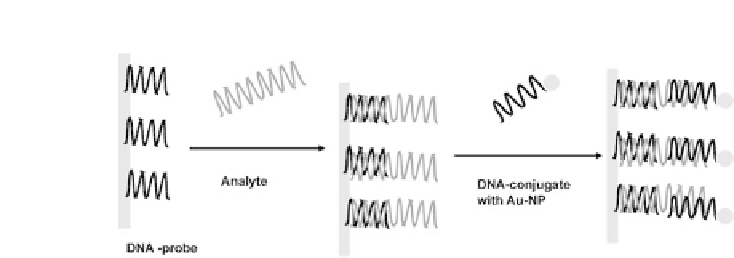Biology Reference
In-Depth Information
Figure 4.1.
Schematic amplification route for DNA sensing using an
oligonucleotide-functionalized nanoparticle asan amplifying unit.
is outlined in Fig. 4.1. The primary probe-DNA recognition event
is accompanied by the coupling of a colloidal gold tag, which is
followed by acid dissolution and anodic stripping electrochemical
measurement of the metal tracer. Sensitivity can be enhanced to
sub-picomolar detection limits by catalytic enlargement of the gold
tracer in connection to nanoparticle-promoted precipitation of gold
[8] orsilver [9, 10].
More complex amplification strategies involve dendritic
nanoparticlesarraysorcouplingwithprobe-coatedmagneticbeads.
The former approach can be visualized in Fig. 4.2 [7]. Two
types of functionalized gold nanoparticles are employed. One
of them is functionalized with a 3'-terminated oligonucleotide
complementary to the 3'-end of the target DNA, whereas the second
type of gold nanoparticle is functionalized with the 5'-terminated
oligonucleotidecomplementary to the 5'-endof the target DNA.
The latter approach involves hybridization of probe-coated
magnetic beads with gold-tagged DNA targets, giving rise to three-
dimensional structures of magnetic beads cross-linked together
through the DNA and gold nanoparticles. No aggregation was
observed in the presence of noncomplementary or mismatched
oligonucleotides [5].
This chapter covers recent advances in the development of DNA
electrochemical biosensors making use of gold nanoparticles to
improve their analytical performance. Aptamer-nanoparticle-based
biosensors will be also covered since using exponential selection
strategies, various RNA and DNA sequences have been identified
that bind small molecules and proteins while inducing a change








